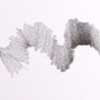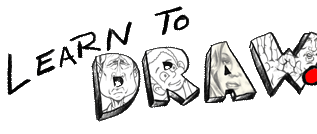 |
|
Practice shading |
 |
 |
|
Let's draw and shade an egg |
To get to know what shading feels like, you might want to practice shading
before you dive in whole hog and shade an object in a
drawing. You can do this by taking a blank piece of
paper and draw short, quick, tight strokes. At first let
the pencil glide very lightly on the paper so you get
very light strokes. Keep shading but begin to push on
the pencil just a little harder to make the strokes get
a little darker. Keep moving the pencil but let up again
and try to make the same shade as when you started. Note
how it feels to shade. Begin to take a mental note of
how hard you have to push to get a certain darkness of
shadow. Try varying your stroke length and how far apart
you make each stroke. Note what happens as you try a new
direction of the stroke. Try drawing horizontal strokes,
then try vertical. Begin to know how it feels to do
shading.
 Let's do some shading! Grab an egg out of your
refrigerator and set it in front of you. Of course it
should be on a flat surface so the egg doesn't roll and
break. If you don't like eggs, or haven't been to the
store lately, you can use the egg on this page. But it
would be better if you had your own egg, because drawing
real-life objects is always better and easier than
drawing from photographs. Let's do some shading! Grab an egg out of your
refrigerator and set it in front of you. Of course it
should be on a flat surface so the egg doesn't roll and
break. If you don't like eggs, or haven't been to the
store lately, you can use the egg on this page. But it
would be better if you had your own egg, because drawing
real-life objects is always better and easier than
drawing from photographs.
 Tape or clip a few sheets of
paper horizontally onto your drawing desk. With your
pencil draw the egg shape in the middle and slightly to
the right of the paper. As you look at the egg on the
table, where is the light source coming from that is
casting the shadow on the egg? What is the quality of
the light - is it a hard light that makes real sharp
shadows or is it a soft light that will create softer,
more gradual, shadows? In the egg photo on this page,
the light is a soft light source. But you knew that,
right? Make a small dot on your paper in the area of
where your light source is. This is to remind you where
your light source is coming from. Tape or clip a few sheets of
paper horizontally onto your drawing desk. With your
pencil draw the egg shape in the middle and slightly to
the right of the paper. As you look at the egg on the
table, where is the light source coming from that is
casting the shadow on the egg? What is the quality of
the light - is it a hard light that makes real sharp
shadows or is it a soft light that will create softer,
more gradual, shadows? In the egg photo on this page,
the light is a soft light source. But you knew that,
right? Make a small dot on your paper in the area of
where your light source is. This is to remind you where
your light source is coming from.
 |
|
How to shade the egg |
 Now we're going to
shade the sphere (actually, it's probably more oval).
Look at the egg and note the shadows. Do you see the
shadows, the midtones and the highlights? The
highlight may be pretty diffuse because an egg isn't a
completely smooth and shiny surface. Start by lightly
shading the entire egg, graying it. Try and use long
strokes that go from one edge to the other. If you use a
bunch of short strokes, you'll probably get many
different tones rather than one smooth one. This is your midtone. Now we're going to
shade the sphere (actually, it's probably more oval).
Look at the egg and note the shadows. Do you see the
shadows, the midtones and the highlights? The
highlight may be pretty diffuse because an egg isn't a
completely smooth and shiny surface. Start by lightly
shading the entire egg, graying it. Try and use long
strokes that go from one edge to the other. If you use a
bunch of short strokes, you'll probably get many
different tones rather than one smooth one. This is your midtone.
 As you look at the shadow on the egg do you
see a sliver of light down near the base of the egg?
That's some reflected light from the table bouncing back
onto the egg. If you have a dark desk you may not see
this reflected light because a dark table isn't going to
reflect light. To draw this spot of reflected light just
don't shade so hard in that area. As you look at the shadow on the egg do you
see a sliver of light down near the base of the egg?
That's some reflected light from the table bouncing back
onto the egg. If you have a dark desk you may not see
this reflected light because a dark table isn't going to
reflect light. To draw this spot of reflected light just
don't shade so hard in that area.
 |
|
The "shadow shapes" on the egg |
 An easy way to
create shading is to look for the shapes that the
shadows and highlights create, then draw these shapes as
toned areas on your drawing. What I mean is this: on the
egg, the highlight creates a pretty round shape, and the
major shadow creates a sort of a crescent shape. Look
for these shadow shapes, and since they don't really
remind your logical mind of anything, they should be
fairly easy to draw. I wouldn't recommend actually
drawing these shadow shapes, like I did in the example,
but just look for them and try and mentally see them on
your drawing. Now, go ahead and shade in the shadow on
the egg. Your shadow should be slightly curved to wrap
around the spherical shape of the egg. You don't even
have to pick up your pencil, just keep the movement
going but let up on the pressure on the pencil to get a
lighter shade for midtone and press harder for shadow.
Now where you see the highlight on the egg, take your
eraser and erase out that spot on your drawing. There's
your highlight. Now, to make it very realistic, draw the
cast shadow. Lightly draw the contour of the cast
shadow, then lightly shade it in with a pretty even
tone. That's pretty easy, huh? That's all shading is:
quick back and forth movements laying down different
amounts of graphite depending on what tone you want to
achieve. An easy way to
create shading is to look for the shapes that the
shadows and highlights create, then draw these shapes as
toned areas on your drawing. What I mean is this: on the
egg, the highlight creates a pretty round shape, and the
major shadow creates a sort of a crescent shape. Look
for these shadow shapes, and since they don't really
remind your logical mind of anything, they should be
fairly easy to draw. I wouldn't recommend actually
drawing these shadow shapes, like I did in the example,
but just look for them and try and mentally see them on
your drawing. Now, go ahead and shade in the shadow on
the egg. Your shadow should be slightly curved to wrap
around the spherical shape of the egg. You don't even
have to pick up your pencil, just keep the movement
going but let up on the pressure on the pencil to get a
lighter shade for midtone and press harder for shadow.
Now where you see the highlight on the egg, take your
eraser and erase out that spot on your drawing. There's
your highlight. Now, to make it very realistic, draw the
cast shadow. Lightly draw the contour of the cast
shadow, then lightly shade it in with a pretty even
tone. That's pretty easy, huh? That's all shading is:
quick back and forth movements laying down different
amounts of graphite depending on what tone you want to
achieve. |
